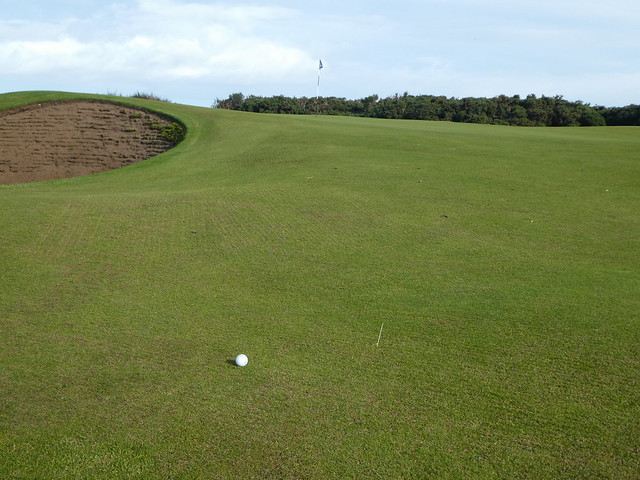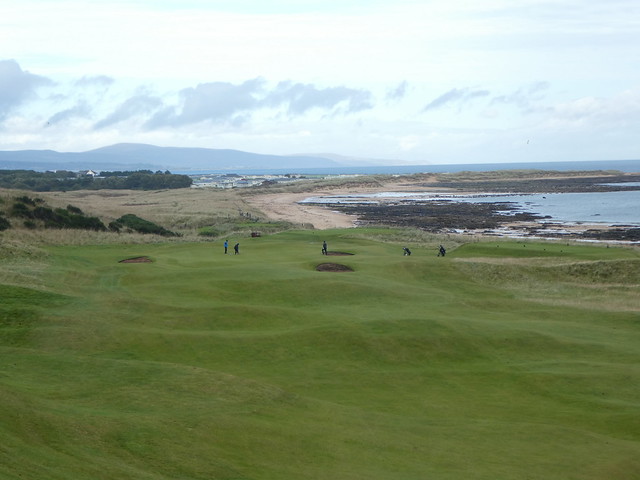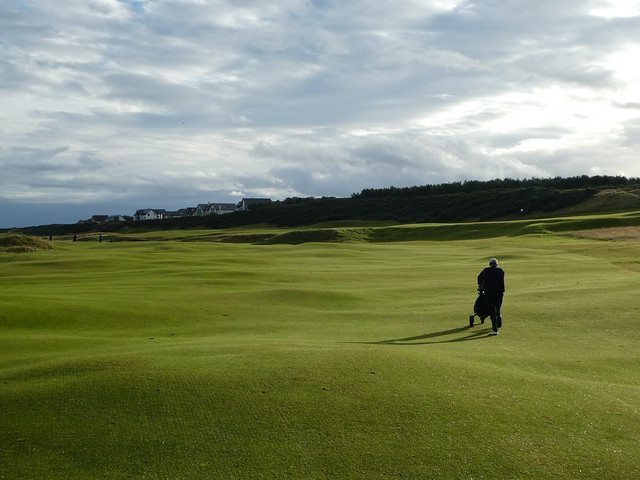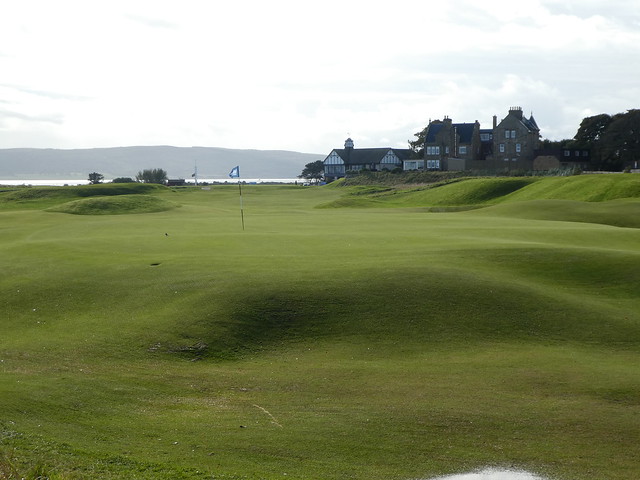Royal Dornoch was the first course I ever blogged about, in a rather short post; after a dozen years I finally had a chance to return and give a more comprehensive write-up.
The golf gods were welcoming on my return visit to Royal Dornoch, rolling out a lovely rainbow as I made my way down the first fairway
One of the finest pieces of writing ever done about golf was written by Herbert Warren Wind in 1964 titled North to the Links of Dornoch, which he penned for the New Yorker. It is an exceptionally written long form essay about the wonders of golf in Scotland. Readers wishing to delve more into it can find it in the book Following Through : Herbert Warren Wind on Golf. Not only does he give an extensive history of the course, but also tells the tale about how at the time of his visit Royal Dornoch was not visited very often because of its location far to the North. He credits Pete Dye with making the trek up and then began to spread the word about it. In Dye's words: "No other links has quite the ageless aura Dornoch does. When you play it, you get the feeling you could be living just as easily in the eighteen-hundreds or even the seventeen-hundreds. If an old Scot in a red jacket had popped out from behind a sand dune, beating a feather ball, I wouldn't have blinked an eye."
Wind's comment about the course is as true today as on the day it was written: "No
golfer has completed his education until he has played and studied Royal
Dornoch."
Although golf has been played on this land since the sixteen-hundreds it was Old Tom Morris that laid out the "modern" nine holes in 1885. According to Wind, "... in 1904, the wholesale changes that transformed Dornoch from just another course into a bona-fide championship layout were carried out under the direction of a remarkable all-round golf man, John Sutherland, who for over fifty years served as the club's secretary."
Wind continues, "Dornoch is a loop-type course--in this instance, eight holes out, ten holes back--but the repetitiousness generally inherent in this kind of layout has been avoided with a fine resourcefulness. On the eight outward holes, which are set along a shelf of high land, the tees have been placed so that the fairways do not swing quite the same way on any two holes, and as a result the wind hits the golfer from all directions. The incoming holes manage a similar diversity by rambling up and down between the crusty higher land and the duneland by the sea."

Lucky is the golfer who visits the linksland of Dornoch when the gorse is in bloom
My return journey (this is my third visit, although the first time I brought a decent camera) was during October, and it was cool and windy. As the local forecast for the day stated, with the usual understated Scottish elegance: “Weather on the turn. A bit drafty.” Since rain was coming in in waves, it prevented an abundance of pictures, but enough for me to give you a flavor.
As is widely known Donald Ross spent considerable time at Dornoch. For those wondering about his penchant for inverted bowl greens like at Pinehurst, the opening green gives a clue.

The golfer missing the second green left faces a tricky uphill shot: putt or hit a wedge fat?
The second hole is a par three with a plateau green, like the first. If you miss left of the second green, this pictures shows
the severity of the wee hill you must navigate. The first two holes are away from the Dornoch Firth and are somewhat isolated. It is only when you walk from the second green to the third tee that the expanse of Dornoch becomes visible. As my friend and fellow golf fanatic Paul Rudovsky puts it, "the rest of the course to the north is open in front of you and the sight is something to behold. It is like someone opened a curtain."
As a classic links, Dornoch has everything you would expect including sand dunes covered with gorse, as can be seen above the fifth hole. The sixth is another perfectly executed par three of roughly 150 yards, also with an elevated green with steep slopes to the right.
It took a while for me to remember the holes at Dornoch and by the time we reached the par four seventh I remembered why this is such a revered course. Seven has a blind tee shot and the fairway tumbles down the hill toward the
North Sea along ancient fairways.

The tricky green on the 7th is situated near the water

The green on the 9th hole, the epitome of pure links golf

The 14th fairway at dusk. The 445 yard hole features no bunkers and doesn't need any!
More from Herbert Warren Wind on Dornoch, "I should imagine that Dornoch usually elicits a golfer's best game. It doesn't overawe you with its length. It keeps you on your toes by making it clear from the outset that it rewards only shots that have been well thought out and executed. And it encourages you to hit decisive shots by providing vigorous, close-cropped turn, on which the ball sits up beautifully, and very true greens, which are a joy to putt. I found Dornoch all I had hope it would be -- a thoroughly modern old links with that rare equipoise of charm and character that only the great courses possess."
The finish at Dornoch is as strong as on any golf course. The par four sixteenth rises up a vertical hill from tee to green and has an oversized putting surface. It is one of my favorites on the course. It is such a simple and elegant use of terrain, it is a wonder you don't see it used more in golf design. The 17th might be the most fun of all the holes on a course with plenty of them. A par four of roughly four hundred yards features a blind tee shot. The course guide describes it aptly as "from the heights to the depths!" because the fairway falls into a big valley. Your shot (either second or third) is at an obtuse angle to an elevated green. Eighteen is a demanding 450-yard par four that isn't too challenging tee to green, but when you approach the final green you see the gully that protects the green. Whoa.
The finish at Dornoch is as strong as on any golf course. The par four sixteenth rises up a vertical hill from tee to green and has an oversized putting surface. It is one of my favorites on the course. It is such a simple and elegant use of terrain, it is a wonder you don't see it used more in golf design. The 17th might be the most fun of all the holes on a course with plenty of them. A par four of roughly four hundred yards features a blind tee shot. The course guide describes it aptly as "from the heights to the depths!" because the fairway falls into a big valley. Your shot (either second or third) is at an obtuse angle to an elevated green. Eighteen is a demanding 450-yard par four that isn't too challenging tee to green, but when you approach the final green you see the gully that protects the green. Whoa.
From my original visit to Dornoch, playing at dawn in a two-some
The English writer, Dell
Leigh wrote the following about Dornoch in 1925 and it is still true today,
"The very journey thither is a pilgrimage of pleasure of the kind which
remains crystal clear in the memory long after the return to the drab side of
life. And the very fact that one cannot say in bold words that the links are
definitely this, that or the other thing instills into the mind a predominant
feeling - the desire vehemently expressed, to play over them again, and then
once more."
I can't wait to return again.






Played Dornoch in the summer of 1995. It hadn't rained much in weeks and course was browned out. Loved every hole. Can't wait to go back, hopefully when the gorse are in bloom.
ReplyDeleteOne of Scotland's most traditional link courses, an old Tom Morris design from 19th century. There is evidence of golf being played on these grounds dating back to 1616. I also love Dornoch for its history. I also have this list of bluetooth speakers for your golf cart. Just click the link.
ReplyDeleteJohn--
ReplyDeleteAs always, great writeup. I would add only one short point. Like most things in life, Herb Wind's New Yorker article was a "double edged sword". Royal Dornoch was a "hidden gem" prior to its publication, unknown to all but a very few. In the decades since, it has rocketed up in popularity (also due to the new bridges that shortened the drive from Inverness). Ahh for the days some 40 years ago when it was frequently almost exclusively by the fast playing Scots!
Best
Paul